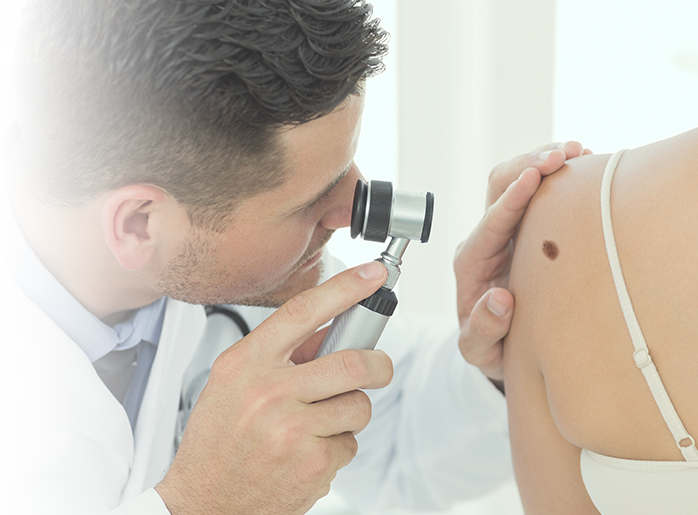Skin Cancer
Know More: Skin Cancer
Trustworthy information, straight from the source. Education is the first step in an empowering healthcare plan. Learn more about skin cancer, from prevention to diagnosis and treatment.

Condition Overview
What is skin cancer?
Skin cancer is the most common type of cancer and anyone can get it. Your risk is increased if you have light colored hair, skin, or eyes. Tanning, a sunburn, or more sun exposure than your healthcare provider recommends can also increase your risk.
Risk Prevention
What are the causes and increased risks of skin cancer?
Skin cancer is caused by mutations that occur in skin cell DNA, which then cause the abnormal cells to multiply out of control. Ultraviolet (UV) radiation is the most common cause of the DNA mutations that cause skin cancer. UV radiation is found in sunlight and tanning lamps and beds.
General skin cancer prevention guidelines:
- Avoid sun exposure between 10 a.m. and 4 p.m. The sun is most intense during the middle of the day.
- Sit in the shade or under an umbrella if you are outside.
- Do not use tanning beds. Tanning beds are not safer than a tan directly from the sun.
Use sunscreen correctly:
- Apply a broad spectrum sunscreen with at least SPF 30, 20 minutes before you go outside. Use sunscreen on cloudy days as well. Apply sunscreen at least every two hours and after you swim or sweat.
- Check the expiration date on your sunscreen. Sunscreens are not as effective after three years.
Wear protective clothing outside:
- Wear long-sleeved shirts and long pants or skirts. Choose dark colors and fabric with a tight weave. Some clothes have an ultraviolet protection factor (UPF) built in. Wear clothes with a UPF of 40 or higher.
- Wear a hat with a wide brim all the way around. The wide brim shades your face, ears, and the back of your neck. If possible, choose a dark-colored hat.
- Wear large-framed sunglasses. Sunglasses protect your eyes. Sunglasses decrease your risk for cataracts and other eye damage caused by the sun. Sunglasses that wrap around the sides of your face work best to keep out all the sun.
Diagnosis & Treatment Options
How is skin cancer diagnosed?
Because moles can become cancerous, it’s important to be aware of the characteristics that can signal skin cancer. Dermatologists use a handy mnemonic device to remember these characteristics: ABCDE.
Asymmetry
- Normal moles generally have a regular shape. If one half of a mole is unlike the other half, the mole is suspicious.
Border
- Normal moles have smooth, even borders. Moles that have irregular, poorly defined, notched, or scalloped borders are suspicious.
Color
- Normal moles are a single color, usually brown or black. Moles that have different shades of color, multiple colors, or atypical colors such as white, blue, or red are suspicious.
Diameter
- Any mole that has a diameter larger than a pencil eraser is suspicious.
Evolving
- Normal moles generally do not change appearance. Any mole that is growing larger, changing shape, or changing color is suspicious.
How is skin cancer treated?
Treatment depends on your cancer, the area affected, and any other health conditions you may have.
Treatments may include:
- Surgery: Surgery is the most common treatment. Your healthcare provider numbs the skin and removes the tumor. They may look at the tissue pieces with a microscope to make sure all of the cancer cells are removed. They may use an electric needle to burn off cancer cells. They may freeze the tumor with a chemical called liquid nitrogen.
- Skin medicines: Your healthcare provider may put medicines on your skin to help remove the cancer. This includes medicines that kill the cancer cells directly or help your immune system to attack the cancer cells.
- Radiation: You may need radiation treatment if you cannot have surgery, are older, or have a large tumor. Radiation therapy uses special X-rays to kill the cancer cells.
Preparing for Care
What questions should I ask my provider about skin cancer?
You should talk to your provider about screening options for skin cancer. By performing a thorough self-skin examination each month and visiting a dermatologist each year for a professional examination, you will be one step ahead in catching skin cancer early.
When should I contact my healthcare provider?
- You have a fever.
- You have chills, a cough, or feel weak and achy.
- You have a mole that changes in shape, size, color, or texture.
- You have questions or concerns about your condition or care.
When should I seek immediate care or call 911?
- You have sudden trouble breathing.
- You have chest pain.
